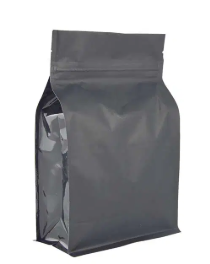As the world shifts toward more sustainable practices, industries are seeking eco-friendly packaging solutions to reduce environmental impact. One such innovation is block bottom bags, which offer durability, efficiency, and a greener alternative to traditional plastic packaging. These bags are widely used in food packaging, agriculture, pet food, pharmaceuticals, and retail, thanks to their ability to provide stability, strength, and recyclability.
But what makes block bottom bags an eco-friendly packaging solution? How do they compare to conventional bags, and what industries benefit the most from using them? This comprehensive guide will explore the environmental benefits, materials, applications, and future trends of eco-friendly block bottom bags.
1. What Are Block Bottom Bags?
Block bottom bags, also known as flat-bottom bags or square-bottom bags, are a type of packaging that features a flat base, allowing them to stand upright without additional support. They combine the best features of a pillow bag and a gusseted bag, making them ideal for packaging products that require stability, easy stacking, and efficient storage.
Key Features of Block Bottom Bags
✔ Flat, sturdy base that enhances stability.
✔ Multiple layers of eco-friendly materials for strength and durability.
✔ Recyclable, biodegradable, or compostable options to reduce plastic waste.
✔ Customizable designs for branding and labeling.
✔ Suitable for food-grade applications, ensuring product freshness and protection.
Unlike plastic pouches, block bottom bags reduce material waste and offer a visually appealing design that enhances shelf presence.
2. Why Are Block Bottom Bags Considered Eco-Friendly?
Traditional plastic packaging contributes significantly to landfill waste and ocean pollution. In contrast, block bottom bags are designed with sustainability in mind, offering several environmental benefits.
1. Made from Sustainable and Recyclable Materials
Many eco-friendly block bottom bags are manufactured using renewable resources such as:
- Kraft paper – A biodegradable and compostable material.
- PLA (Polylactic Acid) – A plant-based plastic alternative derived from corn starch.
- Recyclable polyethylene (PE) and polypropylene (PP) – Reduces waste and promotes circular economy practices.
By choosing biodegradable or recyclable materials, businesses can significantly lower their carbon footprint.
2. Reduces Plastic Waste and Pollution
Unlike single-use plastic bags, block bottom bags use less plastic, are often made from recycled content, and can be recycled or composted after use. This minimizes plastic pollution in landfills and oceans, making them an environmentally responsible choice.
3. Enhances Product Protection, Reducing Food Waste
Food waste is a major environmental issue, and proper packaging plays a crucial role in preserving freshness. Block bottom bags provide:
✔ Barrier protection against moisture, air, and contaminants.
✔ Extended shelf life for dry goods like coffee, tea, and flour.
✔ Minimized food spoilage and wastage, reducing the carbon footprint of discarded products.
4. Supports Sustainable Branding and Consumer Demand
Consumers are becoming increasingly eco-conscious, and brands that use sustainable packaging can appeal to environmentally aware buyers. Many companies print eco-friendly labels and certifications on their block bottom bags, such as:
✔ FSC-certified paper (responsibly sourced wood fibers).
✔ Compostable packaging certifications for plant-based materials.
✔ Recycling symbols to educate consumers on proper disposal.
As businesses move toward sustainability, block bottom bags provide an excellent opportunity to align with green packaging trends.
3. Common Applications of Eco-Friendly Block Bottom Bags
Block bottom bags are widely used across multiple industries due to their versatility, durability, and sustainability.
1. Food Packaging Industry
✔ Coffee & Tea – Maintains freshness with airtight seals.
✔ Flour & Sugar – Sturdy packaging prevents contamination.
✔ Snack Foods – Provides lightweight, resealable options for chips, granola, and nuts.
2. Pet Food Packaging
✔ Dry pet food stays fresh and moisture-free.
✔ Custom-printed designs help brands differentiate products on shelves.
3. Agricultural and Fertilizer Packaging
✔ Stores seeds, grains, and fertilizers while protecting contents from moisture.
✔ Heavy-duty paper or biodegradable plastic options reduce environmental impact.
4. Pharmaceutical and Healthcare Packaging
✔ Herbal medicines, vitamins, and supplements benefit from air-tight storage.
✔ Ensures compliance with sustainable packaging regulations.
5. Retail and E-commerce Packaging
✔ Fashion brands use biodegradable block bottom bags for eco-friendly shipping.
✔ Luxury and boutique packaging creates a premium brand experience.
Regardless of the industry, eco-friendly block bottom bags serve as an excellent alternative to traditional plastic-based packaging, offering both functionality and sustainability.
4. How to Choose the Right Eco-Friendly Block Bottom Bag
With various sustainable materials and design options, choosing the right block bottom bag depends on your business needs. Consider the following factors:
1. Material Selection
✔ Compostable Kraft Paper – Best for organic and natural products.
✔ PLA-Based Bags – Suitable for food and beverage applications.
✔ Recyclable PE or PP Bags – Provides durability while being environmentally responsible.
2. Barrier Properties
✔ If packaging food, select bags with moisture and oxygen barriers.
✔ For powdered goods, choose bags with anti-static layers to prevent clumping.
3. Resealable Features
✔ Zipper closures allow consumers to reuse the packaging, reducing waste.
✔ Tin ties or heat-sealed tops preserve freshness.
4. Branding and Customization
✔ Use eco-friendly soy-based inks for printing.
✔ Highlight sustainability certifications to attract eco-conscious buyers.
Selecting the right block bottom bag enhances product quality while aligning with sustainable business practices.
5. Future Trends in Eco-Friendly Block Bottom Bags
As the demand for sustainable packaging grows, new innovations continue to improve block bottom bags.
1. Biodegradable and Compostable Innovations
- Research is expanding into bio-based materials that completely decompose within months.
- Edible coatings are being tested to replace plastic laminations.
2. Smart Packaging Technology
- QR codes on packaging allow consumers to scan and check recycling instructions.
- Embedded sensors in future designs may track freshness and expiration dates.
3. Minimalist and Zero-Waste Packaging
- More brands are eliminating excess layers in favor of single-material designs that are easier to recycle.
- Refillable packaging systems are being developed to reduce single-use waste.
These advancements will make block bottom bags an even more sustainable option, helping businesses meet environmental goals while maintaining quality packaging solutions.
Conclusion
The shift toward eco-friendly packaging is more than a trend—it’s a necessity. Block bottom bags provide a sustainable, durable, and functional alternative to traditional plastic packaging. By using materials like compostable kraft paper, PLA, and recyclable plastics, these bags help reduce waste, lower carbon footprints, and align with consumer preferences for green solutions.
Whether used for food, pet products, pharmaceuticals, or retail, block bottom bags offer businesses an opportunity to promote sustainability while maintaining product integrity. By embracing innovative materials and sustainable designs, companies can contribute to a greener future while meeting modern packaging needs.
Switching to eco-friendly block bottom bags is not just good for business—it’s a step toward protecting the planet for future generations.









